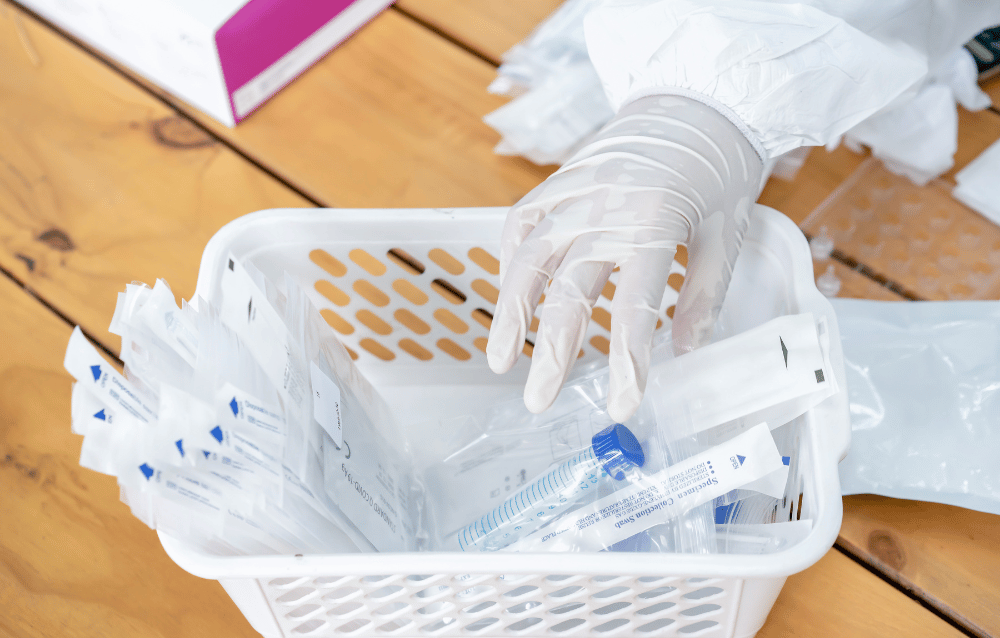5 Must-have Design Features for All Diagnostic Test Kit Packaging
Medical
March 1, 2023Reading time: 3 minutes

In vitro diagnostics (IVDs) are tests done on blood or tissue samples extracted from the human body. The Food and Drug Administration (FDA) defines IVDs as having a dual purpose: Testing may be administered to detect diseases or other conditions, or to monitor overall patient health to help cure, treat, or prevent diseases.1
Likewise, IVDs are generally used in two settings: Medical laboratories may be used for comprehensive IVD analysis, or testing can be done at the point of care (including at home) for quicker diagnosis.
The public is well aware of some of the most common point-of-care IVD tests — blood glucose monitoring, pregnancy tests, and urinalysis test strips. However, the global pandemic brought heightened awareness to diagnostics. Consumers gained a clearer understanding of how they can advocate for personal wellness and, quite literally, take their health in their own hands with point-of-care IVD testing.
COVID-19 rapid test kits are still in high demand, as are vaccination programs. The ongoing need for point-of-care protection against the virus means IVD testing kits must reach clinics, hospitals, and homes safely. To that end, diagnostic test kit packaging for IVDs related to the pandemic and in general has come under closer scrutiny.
Are your diagnostics packaging solutions keeping pace with new market needs and innovation?
Guidelines & Regulations For Diagnostic Test Kit Packaging
IVDs are classified as IVDs under the Federal Food, Drug, and Cosmetic Act 201(h), and as biological products in the Public Health Service Act (§351).2
As such, medical manufacturers must have a quality system in place that follows the good manufacturing practices laid out in 21 CFR 820, which stipulates packaging and labeling requirements.
Also, because diagnostic specimens are considered hazardous materials for shipping, the U.S. Department of Transportation (USDOT), the International Air Transport Association (IATA), and the U.S. Centers for Disease Control and Prevention (CDC) enforce packaging regulations regarding shipment of diagnostic specimens.3
On the whole, medical manufacturers are bound by these national and international laws and guidelines. Speaking specifically to point-of-care diagnostic test kit packaging, combining regulations with innovation is imperative as consumer familiarity with and expectations for IVDs continue to increase.
At-home Testing: Unique Packaging Challenges & Opportunities
Administering at-home IVDs is convenient — which appeals to users — but there are some inherent limitations:
- The environment is less controlled compared to clinical settings
- There is a reasonable assumption that at-home users don’t have the same level of training as clinicians in test administration
- Test kit storage, handling, opening, and sample collection may be arbitrary and potentially affect test results
Diagnostic test kit packaging, then, takes on an added level of importance in reducing risk to users on par with protecting the IVD. Medical manufacturers are tasked with collaborating with packaging suppliers to design diagnostics packaging solutions that:
- Are constructed from materials that are robust enough to withstand unpredictable handling both in distribution and by users4
- Incorporate enhanced barrier properties pertaining to moisture and light resistance4
- Promote extended shelf life as users may not immediately use the IVD, or purchase several at one time for intended future use4
- Instill user confidence about product reliability, in general, and their ability to easily and intuitively access the test kit4
5 Design Features for Innovative IVD Packaging
The shifting priorities of diagnostic test kit packaging present challenges and opportunities. Working with an experienced medical packaging professional is key in keeping pace with rapid change, as is leveraging design features that balance usability and innovation:
- Materials: Are the packaging materials and IVD compositionally compatible?
- Protection: Is the IVD adequately protected from damage or contamination during transport, distribution, and possible mishandling by users?
- Barriers: Does the packaging provide high barrier resistance to moisture, light, and chemicals to ensure proper testing at point of care, even if the kit sits on the shelf for an extended period of time?
- Accessibility: Does the diagnostic packaging solution have opening features that make it easy for users to access the IVD?
- Reagent Release: How are reagents released? Do the packaging materials peel, pierce, or tear to access these chemically reactive substances and compounds?
Diagnostics Packaging Solutions: Amcor Dessiflex® Technology
As a global thought leader in medical packaging, Amcor saw the opportunity to innovate around the patented Dessiflex® technology to create diagnostic packaging solutions that are practical and progressive.
Initially designed to protect the quality and efficacy of moisture-sensitive pharmaceuticals, Dessiflex® has proven to be as effective when used in point-of-care IVD applications.
Dessiflex® laminates:
- Incorporate desiccant into the packaging sealing layer that eliminates the need for additional moisture scavengers and ensures contamination-free moisture protection
- Combine chemical desiccants and aluminum layers to protect IVDs against humidity, gas and UV light — with the desiccant chemically binding with moisture preventing it from being released back into the packaging
- Streamline inventory, packaging, and production by getting rid of a separate desiccant sachet
- Reduce packaging’s carbon footprint up to 32% by decreasing pack size
Diagnostic test kit packaging is becoming more innovative, practical, and in line with customer expectations. Working with a trusted, experienced packaging provider is the surest way to stay ahead of the design curve and competition. Click Evaluate My Packaging below to request a packaging needs assessment.

SOURCES
1U.S. Food and Drug Administration, In Vitro Diagnostics | FDA, Undated
2U.S. Food and Drug Administration, Overview of IVD Regulation | FDA, Undated
3U.S. Centers for Disease Control and Prevention, Diagnostic Specimen Packing and Transportation Requirements, Undated
4MedTech News, Moving with the times: Changes in diagnostic packaging - Med-Tech Innovation, August 10, 2021
Segment Marketing Manager
